Biomechanics of the Medial Plantar Arch - Flat/High-Arched Foot
Dr. Mauro Lastrico
Extract from:
"Musculoskeletal Biomechanics and Mézières Methodology"
Author: Dr. Mauro Lastrico
Marrapese Publisher
Medial Plantar Arch
The muscles capable of modifying the medial plantar arch are:
Anterior leg muscles
* Tibialis anterior
* Extensor digitorum longus
* Peroneus longus
Posterior leg muscles
* Triceps surae
* Tibialis posterior
* Flexor hallucis longus
* Flexor digitorum longus
Muscles of the sole of the foot
* Abductor hallucis
* Flexor hallucis brevis
* Adductor hallucis
* Quadratus plantae
The following table considers the action of the muscles and their effect on the medial arch, while the reader is referred to anatomy texts for origin and insertion.
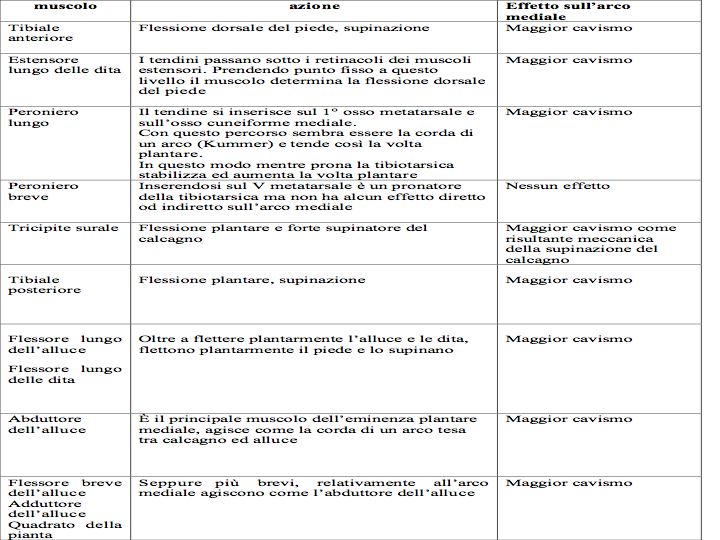
As highlighted, the muscles acting on the medial plantar arch all act in support of the arch itself.
In all joints analyzed, although in vector imbalance, the acting forces antagonize each other. The medial arch has the peculiarity of having all muscle vectors in summation of action.
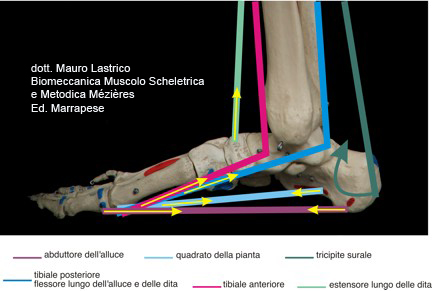

From an "engineering" point of view this is not surprising, since the medial arch is responsible for supporting the entire body weight (in standing position the body center of gravity is discharged at the apex of the medial arch). It is therefore understandable that all the "ties" act to support the ligaments and the arched bone conformation.
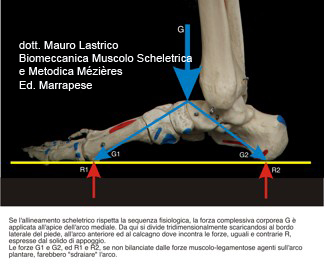
Architecturally, the arch is able to support large vertical loads provided the bases are stable, otherwise the arch collapses.
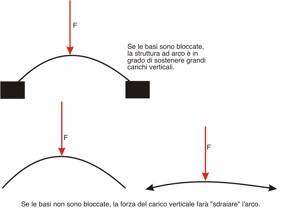
Muscular action is therefore aimed at supporting the bases.
Moreover, since the medial plantar arch is not made up of a single bone, which would make it stable but rigid and inadequate to withstand dynamic stresses, the musculo-ligamentous tension assumes further importance. This tension, if expressed at the minimum necessary, dynamically stabilizes the plantar vault.
High arch foot
Determined by the excess tension of all the muscles that directly and indirectly (the triceps surae increases the arch through calcaneal supination and therefore, as a mechanical resultant) act on the medial plantar arch.
Flat foot
Since the action of all the acting muscles is directed at supporting the medial arch, the collapse of the plantar vault must be determined by a relevant structural bone deformation, preventing the muscular "ties" from forming the arch._Or by peripheral neurological paralysis with consequent muscular inactivity or by other specific pathological conditions.
It will therefore be necessary to differentiate, in the presence of a flat footprint, whether the latter is caused by true flatfoot (with collapse of the plantar vault) or by hypertrophy of the muscles of the plantar vault, and expression of an adaptive mechanism of other problems.
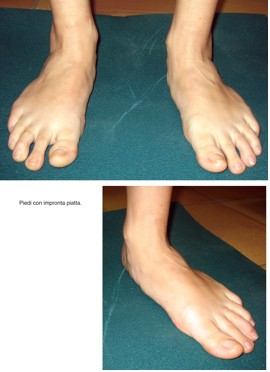
The first investigation will be manual aimed at perceiving the position of the arch:
in case of a real collapse of the vault, talus, navicular and cuneiforms will appear in a horizontal position; otherwise the bony arch will appear intact and palpation will highlight hypertrophy of the plantar muscles.
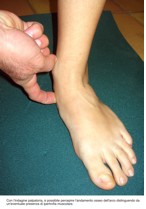
If the arch is intact and the flat footprint expresses muscular hypertrophy, adaptive mechanisms will be analyzed.
In standing position (still in the previous patient) there is an important internal rotation of the femurs.
Asking for active correction of femoral internal rotation the feet, particularly the right one, go into high arch.
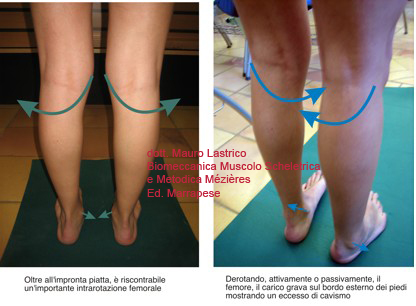
In this case an adaptive mechanism occurs: with the femurs correctly positioned, the feet are in excess cavus, with support on the lateral border of the foot due to the tension of the supinators and the intrinsic muscles of the sole of the foot.
The pronator muscles of the tibio-tarsal joint, being vectorially subdominant to the supinators, cannot balance the supinators and make the sole of the foot rest on the ground. Moreover, the main pronator, the peroneus longus, also contributes to the excess cavus.
In pursuing the goal of supporting the sole of the foot, the femoral intrarotators substitute the action of the pronators by internally rotating the lower limb.
By doing so, they enable the sole to adhere to the ground. The heel will show a non-primary valgus, consequential to the internal rotation of the lower limb.
In this case, therefore, the apparent flat foot is caused by a cavus foot compensated upstream through femoral and tibial rotation, using muscles not directly acting on the foot.
Through the linear study of muscle vectors, it is therefore possible to analyze whether articular balancing is achievable between antagonistic muscles acting on the joint or if, as in the case of apparent flat foot, such balancing takes place through the use of muscles not directly acting on the joint under examination.
In similar situations, acting locally by means of external devices to correct the apparent flatness, compensations in worsening other body districts may occur.
The application of external means should therefore be assessed not only in the skeletal district of application but, through postural investigation, on the whole body system.

Copyright © 2025 AIFiMM Formazione Mézières Provider E.C.M. n. 1701. All rights reserved.



